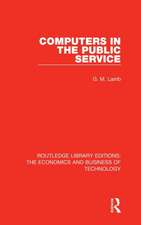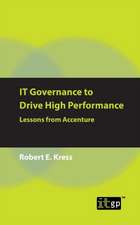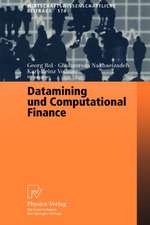The Quantum Dot
Autor Richard Turtonen Limba Engleză Paperback – 31 aug 1996
Now, in The Quantum Dot, physicist Richard Turton provides a clear, informative look at the science that lies behind the modern revolution in microelectronics and offers an intriguing glimpse of the possible future of this rapidly evolving field. Turton illuminates the development of the microchip, in a discussion that ranges from a primer on atoms and electrons, to the properties of semiconductors (most notably, silicon), to the structure of the transistor. We learn how researchers have managed to pack the tiny silicon chip with more and more bits, and we get a state-of-the-art look at the microelectronic industry today, from the newest chip materials (such as gallium arsenide, a much faster material than silicon, used in the recently released Cray 3 supercomputer) to the exotic world of high-temperature superconductors. Perhaps most interesting, Turton offers a provocative glimpse of the future of microelectronics. Here readers enter the strange realm where quantum theory prevails and where physical events contradict our intuitive perceptions. Turton shows how researchers are leaving the transistor far behind as they struggle to exploit quantum effects to create incredibly small and fast devices, such as "designer atoms" and the quantum dot. He concludes that the range of future possibilities are immense, including devices in which electrons behave not as particles but as waves, and computers in which there are no electrical signals, only beams of light.
Here then is an amazing scientific--and economic--success story, told with clarity and expertise. It will fascinate anyone curious about where modern technology is headed and what the world might look like when it gets there.
Preț: 364.57 lei
Nou
Puncte Express: 547
Preț estimativ în valută:
69.77€ • 72.47$ • 57.96£
69.77€ • 72.47$ • 57.96£
Carte tipărită la comandă
Livrare economică 03-17 februarie 25
Preluare comenzi: 021 569.72.76
Specificații
ISBN-13: 9780195109597
ISBN-10: 0195109597
Pagini: 224
Dimensiuni: 155 x 232 x 17 mm
Greutate: 0.39 kg
Editura: Oxford University Press
ISBN-10: 0195109597
Pagini: 224
Dimensiuni: 155 x 232 x 17 mm
Greutate: 0.39 kg
Editura: Oxford University Press
Descriere
Since first developed in the early sixties, silicon chip technology has made vast leaps forward. From a rudimentary circuit with a mere handful of transistors, the chip has evolved into a technological miracle, packing millions of bits of information on a surface no larger than a human thumbnail. And most experts predict that in the near future, we will see chips with over a billion bits. At the same time, this revolution in microelectronics has sparked a dramatic change in the way we live. An integral part of the computer industry, the microchip is found in everything from lasers, fax machines, and satellites to greeting cards and children's toys. And yet few people have any idea how chips work, or how so much information can be captured in such a miniscule space. Now, in The Quantum Dot, physicist Richard Turton provides a clear, informative look at the science that lies behind the modern revolution in microelectronics and offers an intriguing glimpse of the possible future of this rapidly evolving field. Turton illuminates the development of the microchip, in a discussion that ranges from a primer on atoms and electrons, to the properties of semiconductors (most notably, silicon), to the structure of the transistor. We learn how researchers have managed to pack the tiny silicon chip with more and more bits, and we get a state-of-the-art look at the microelectronic industry today, from the newest chip materials (such as gallium arsenide, a much faster material than silicon, used in the recently released Cray 3 supercomputer) to the exotic world of high-temperature superconductors. Perhaps most interesting, Turton offers a provocative glimpse of the future of microelectronics. Here readers enter the strange realm where quantum theory prevailsand where physical events contradict our intuitive perceptions. Turton shows how researchers are leaving the transistor far behind as they struggle to exploit quantum effects to create incredibly small and fast devices, such as "designer atoms" and the quantum dot. He concludes that the range of future possibilities are immense, including devices in which electrons behave not as particles but as waves, and computers in which there are no electrical signals, only beams of light. Here then is an amazing scientific--and economic--success story, told with clarity and expertise. It will fascinate anyone curious about where modern technology is headed and what the world might look like when it gets there.
Recenzii
"It is a close-printed account of the physics behind computers and telecomms, and the binary maths and logic too, all beautifully packed into clear futurology based on sound well-told history....It's all well told, and well illustrated too....Invaluable."--SSR |k No
"With unusual thoroughness--one might say patience--the author explains the physical effects used in the design of semiconductor devices in terms of simple concepts, drawing analogies to tennis balls and pieces of string....Its usefulness need not stop at the lay person; an intuitive scientist will also get a charge out of it."--Andrew Holmes-Siedle, Nature
"Very readable, and a must for anyone with a passing interest in how modern semiconductor chips work."--New Scientist
"Turton breaks new ground by presenting popular physics with the motivation for application."--Times Higher Education Supplement
"With unusual thoroughness--one might say patience--the author explains the physical effects used in the design of semiconductor devices in terms of simple concepts, drawing analogies to tennis balls and pieces of string....Its usefulness need not stop at the lay person; an intuitive scientist will also get a charge out of it."--Andrew Holmes-Siedle, Nature
"Very readable, and a must for anyone with a passing interest in how modern semiconductor chips work."--New Scientist
"Turton breaks new ground by presenting popular physics with the motivation for application."--Times Higher Education Supplement
Notă biografică
Richard Turton is Computer Officer in the Physics Department, University of Newcastle Upon Tyne.
Textul de pe ultima copertă
In The Quantum Dot, physicist Richard Turton reveals the science behind the microelectronic revolution and provides us with a tantalizing peek at the future of this rapidly evolving field. Turton's clear explanations and engaging style make this a book that will appeal to the armchair scientist while sacrificing nothing of the complexity that the more sophisticated reader will demand. The range of future possibilities is immense, and thanks to The Quantam Dot, we can follow the progress of modern technology and glimpse how new the world might look.



























